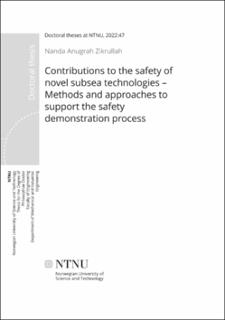| dc.contributor.advisor | Lundteigen, Mary Ann | |
| dc.contributor.advisor | Kim, HyungJu | |
| dc.contributor.advisor | van der Meulen, Meine | |
| dc.contributor.author | Zikrullah, Nanda Anugrah | |
| dc.date.accessioned | 2022-02-22T13:13:13Z | |
| dc.date.available | 2022-02-22T13:13:13Z | |
| dc.date.issued | 2022 | |
| dc.identifier.isbn | 978-82-326-6561-7 | |
| dc.identifier.issn | 2703-8084 | |
| dc.identifier.uri | https://hdl.handle.net/11250/2980801 | |
| dc.description.abstract | This PhD thesis explains the contributionmade to the safety of novel subsea technologies. It is supported by this thesis objective, which is to develop and demonstrate the application of new safety assessment methods within the scope of functional safety, which can capture and manage the complex operational behaviour of novel software-intensive systems. The objective is supported by several study cases, focusing primarily on novel subsea systems for the oil and gas industry. The novel and complex characteristics of the systems are represented in the concept of integrating the control and safety elements. The following five research questions’ topics have been addressed explicitly:
• Topic I – Safe design principles. This study clarifies several safe design principles that are derived from the design approaches in several industries. It is found that the governing functional safety standard, IEC 61508, is aligned with the safe design principles. These principles have been applied to the study case. The implication is that some processes need to be adapted for novel technology involving software-intensive systems with complex operational behaviours.
• Topic II – Solution-specific safety requirements. Two hazard analysis approaches that are often considered well suited for hazard analysis of novel technology, i.e., functional hazard analysis (FHA) and systems-theoretic process analysis (STPA) has been compared. The authors investigate the characteristics of both methods in more detail by performing study cases on an equipment protection system in subsea processing applications. It is concluded that STPA is more suitable based on various factors, including the method’s approach, modelling coverage, and analysis capability. The study also provides recommendations for the improvement of both methods.
• Topic III – Alternative concepts. The study proposes a new classification method to distinguish different integration types, from complete independence to complete integration. STPA is then performed several times on systems with different levels of integration at the logic solver. The study also proposes a modelling technique in STPA to capture the different integration types. The result found that integration does not necessarily change the system’s functionality, but it may introduce new interactions leading to hazards. Nevertheless, the magnitude of risk for the hazard is unknown.
• Topic IV – Effect on risk. The study proposes a modelling pattern to quantify the hazardous scenarios’ frequency. A text-based finite-state automata modelling pattern implemented in Altarica 3.0 has been developed. The authors demonstrate the approach capability by performing a study case on the STPA results from the topic III study. It is found that the method is capable of capturing dependencies while also highlighting the inefficiency of STPA caused by unnecessary requirement productions. The study also discusses the method’s limitation if compared with other quantification processes recommended in the standards.
• Topic V – Safety argumentation. This topic summarises all the preceding results to clarify the link between the developed methods and approaches with the safety argumentation concept for novel technology. The concept is based on an argument-induced evidence model. While the PhD works do not cover all aspects of the safety argumentation concept, this PhD highlights the current state of the research and the required further works to build a complete safety demonstration framework for novel technology.
The overall implications of the framework andmethods developed in this PhD thesis are that the engineers or analysts now have more assurance during the safety demonstrations process of novel technology involving software-intensive systems. The overall development process for the framework has been explained in this thesis and scrutinized through a systematic peer review process. This thesis also serves as an input for the ongoing joint industry research project Safety 4.0, which aims to enable and accelerate the uptake of novel subsea solutions by developing a standardized safety demonstration framework. | en_US |
| dc.language.iso | eng | en_US |
| dc.publisher | NTNU | en_US |
| dc.relation.ispartofseries | Doctoral theses at NTNU;2022:47 | |
| dc.relation.haspart | Paper 1: Zikrullah, Nanda Anugrah; Kim, Hyungju; Lundteigen, Mary Ann; van der Meulen, Meine J. P. Clarifying Implementation of Safe Design Principles in IEC 61508: Challenges of Novel Subsea Technology Development. I: Proceedings of the 29th European Safety and Reliability Conference(ESREL). 22 – 26 September 2019 Hannover, Germany. Research Publishing Services 2019 Copyright 2019 Research Publishing Services. | en_US |
| dc.relation.haspart | Paper 2: Zikrullah, Nanda Anugrah; Kim, Hyungju; van der Meulen, Meine J. P.; Skofteland, Gunleiv; Lundteigen, Mary Ann. A comparison of hazard analysis methods capability for safety requirements generation. Proceedings of the Institution of Mechanical Engineers. Part O, Journal of risk and reliability 2021 ;Volum 235.(6) s. 1132-1153 Copyright 2021 Reprinted by permission of SAGE Publications. | en_US |
| dc.relation.haspart | Paper 3: Zikrullah, Nanda Anugrah; van der Meulen, Meine; Skofteland, Gunleiv; Lundteigen, Mary Ann. A Comparison of Hazardous Scenarios in Architectures with Different Integration Types. I: e-proceedings of the 30th European Safety and Reliability Conference and 15th Probabilistic Safety Assessment and Management Conference (ESREL2020 PSAM15). Research Publishing Services 2020 ISBN 9789811485930. s. 4001-4008 Copyright 2021 Research Publishing Services. | en_US |
| dc.relation.haspart | Paper 4: Zikrullah, Nanda Anugrah; van der Meulen, Meine; Lundteigen, Mary Ann. Finite-state automata modeling pattern of systems-theoretic process analysis results, Reliability Engineering & System Safety. This article is awaiting publication and is therefore not included. | en_US |
| dc.title | Contributions to the safety of novel subsea technologies - Methods and approaches to support the safety demonstration process | en_US |
| dc.type | Doctoral thesis | en_US |
| dc.subject.nsi | VDP::Teknologi: 500 | en_US |

